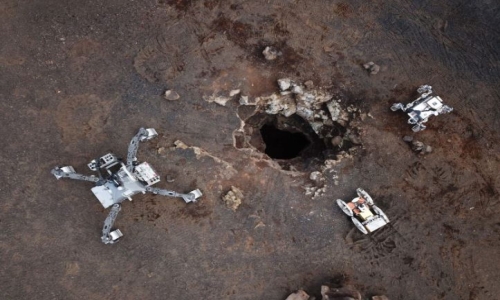


 12:9:55
12:9:55  2025-03-30
2025-03-30  736
736

ORNL scientists created a chip that integrates multiple quantum photonic functions, enabling broadband entangled qubits compatible with fiber-optic networks, bringing us closer to a scalable quantum internet.
Quantum information scientists at the Department of Energy’s Oak Ridge National Laboratory have successfully demonstrated, for the first time, a device that combines key quantum photonic capabilities on a single chip for the first time.
Published in Optica Quantum, the study centers on a form of quantum computing that uses photons, particles of light, to create qubits and to transmit and store information. Unlike classical bits, which represent either 0 or 1, qubits can exist in multiple states at once through a phenomenon known as quantum superposition. This enables more complex and powerful information encoding. The research also advances the foundation for quantum networking, which aims to link quantum devices across distances—a critical step toward realizing a quantum internet.
A Compact, Scalable Platform
“We’re not the first to put any one of these elements on a chip, but we’re the first to put these specific capabilities on a single one,” said Joe Lukens, senior author of the study and an associate professor at Purdue University with a joint faculty appointment at ORNL. “These chips can be manufactured at standardized specifications, which is the key to ensuring mass production at scale. A product like this takes us beyond tabletop demonstrations and on the path toward a quantum internet that anyone can use.”
The ORNL team encoded qubits on photons and generated entangled qubit pairs, meaning pairs of qubits so intertwined that the qubits shared properties even when separated in space. The team created broadband polarization entanglement, a necessary ingredient for various types of quantum networks, in a fully integrated circuit comparable to the electrical transistor relied on by classical computers. Broadband polarization entanglement uses the direction of a light wave’s vibration to encode information on photons across a wide spectrum of wavelengths.
Leveraging Existing Infrastructure
Those photonic qubits can be transmitted over existing fiber-optic hardware, which would eliminate much of the cost of installing new infrastructure. That kind of portability could help lead to a more stable and secure quantum internet.
The process of generating and encoding those qubits remains expensive and time-consuming, but integrated quantum photonics such as those deployed on the team’s new chip could help overcome that obstacle.
“If we can mass produce a chip that has all the components we need to generate the necessary polarization entanglement, then it becomes a matter of plugging the chips into a network without having to buy and align all these specialized tabletop components,” said Alexander Miloshevsky, an ORNL postdoctoral research associate and co-author of the study.
Inside the Chip: Key Components and Capabilities
The chip design incorporates key components such as a microring resonator, which allows entangled photon pairs to be generated, and polarization splitter-rotators, which separate the input light into different output paths depending on the light’s polarization. Pairing the components on a single chip enables direct generation of broadband polarization entanglement.
“These photons are compatible with the traditional fiber-optic cable networks that already exist,” said Hsuan-Hao Lu, an ORNL quantum research scientist and co-author of the study. “Once we can generate and manipulate these photons, we can use everyday, off-the-shelf telecom components for much of the work that’s left.”
Record-Breaking Channel Performance and Future Potential
The chip demonstrated more than 116 distinct pairs of channels, or colors of light waves, for transmission. More than 100 of those channels had a high fidelity – what the team described as a “record number.”
By using microring resonators for pair generation, the team’s design could ultimately enable the creation of hyperentangled qubits, which would be entangled in more than one way, such as by polarization and by color.
“The more degrees of freedom we can use to entangle and encode these qubits, the more information we can potentially pack in,” Lukens said. “One rough metaphor for entanglement is a pair of multifaceted dice that, although individually rolling completely random results, always match. When multiple degrees of freedom — color, polarization, and so on — are entangled, it’s like having access to several pairs of these dice at once, each of which can be used for communication. That’s hyperentanglement.
“All of these studies are pieces of a larger picture that eventually gets us to a quantum internet. We don’t know exactly what the final result will look like, but everything we learn gets us a little closer.”
Reality Of Islam |
|

A new NURBS

A research

Researchers
 9:3:43
9:3:43
 2018-11-05
2018-11-05
10 benefits of Marriage in Islam
 7:5:22
7:5:22
 2019-04-08
2019-04-08
benefits of reciting surat yunus, hud &
 9:45:7
9:45:7
 2018-12-24
2018-12-24
advantages & disadvantages of divorce
 11:35:12
11:35:12
 2018-06-10
2018-06-10
 6:0:51
6:0:51
 2018-10-16
2018-10-16
 7:45:39
7:45:39
 2018-06-21
2018-06-21
 9:39:36
9:39:36
 2022-12-28
2022-12-28
 8:21:9
8:21:9
 2018-06-21
2018-06-21
 6:0:8
6:0:8
 2023-03-19
2023-03-19
 7:32:24
7:32:24
 2022-02-14
2022-02-14
 6:14:17
6:14:17
 2018-06-21
2018-06-21
 2:34:48
2:34:48
 2022-01-18
2022-01-18
 5:41:46
5:41:46
 2023-03-18
2023-03-18
| LATEST |